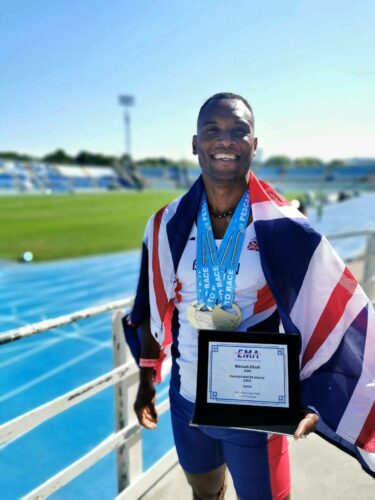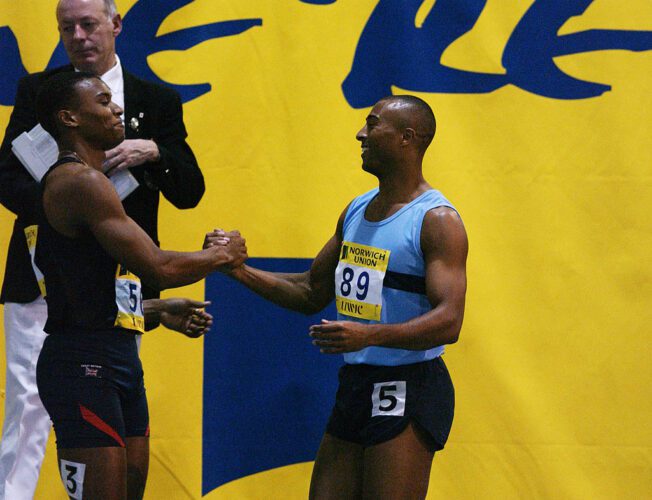increase your flexibility, pace and power as a masters hurdler with recommendation from Neuff ambassador Mensah Elliott
“A great deal of individuals concern the hurdles as a result of it’s the pure human response to obstacles and potential ache, isn’t it?” Mensah Elliott jokes. “Folks all the time inform me, ‘You should be both silly or loopy to run and soar over an impediment at full pace’. However it’s enjoyable. I adore it. Which is nice, as a result of I’ve been doing it for 30 years.”
And, during the last three many years, Mensah has achieved one thing that many people can solely dream about: competing on the worldwide stage as each a senior and a masters athlete.
Now, as many people battle to retain even a semblance of pace and power – to not point out mobility – Elliott defies his M45 age by nonetheless being aggressive over the total 3ft 6in senior peak hurdles: in February, he was invited to compete on the UK Indoor Championships in Birmingham.
So, he’s the proper candidate to show masters athletes how finest to keep up the bodily attributes required for hurdling: pace, power, and suppleness, which is what he’ll be doing partially certainly one of this weblog.
(Keep tuned for half two, which is able to give attention to hurdles spacing and perfecting your begin).

30 years of hurdling success, with just a few breaks within the combine!
Rising up in The Gambia, Elliott sprinted in all places: to highschool, to the outlets, to see his pals. In all places he went, he ran. Quick.
As a scholar at Saint Augustine’s Excessive Faculty, he excelled in athletics, competing in sprints, javelin, and shot put. And, impressed by Linford Christie’s 1992 Olympic 100m victory, he set his sights on turning into a high athlete.
After transferring to England in 1993, Elliott joined Blackheath Harriers and centered on the sprints, nonetheless it wasn’t till late within the 1996 season that the hurdles grew to become part of Elliott’s coaching programme, when he tried his hand on the decathlon.
By 1999, he was among the many UK’s high hurdlers, rating fourth nationally in 2000-2001. He went on to characterize Nice Britain and England in main competitions, together with the 2002 Commonwealth Video games.
However a critical again damage lower his senior profession quick. After taking a 12 months off, the ache disappeared and he gave it one other go – nevertheless it wasn’t the identical. One other six-year break adopted earlier than he returned as a masters athlete, this time with a greater understanding of his physique and practice for longevity.
Representing The Gambia, he gained silver on the 2012 World Masters Championships. He continued to make his mark, setting British, European, and World Masters data within the 60m hurdles and 110m hurdles. Through the years, he’s claimed a number of nationwide and worldwide titles, cementing his standing as one of many world’s high masters hurdlers.
Right this moment, Elliott stays devoted to the game, balancing competitors with teaching. He takes satisfaction in mentoring junior athletes, passing on his experience and expertise by way of the S-Issue Academy. He’s additionally a passionate advocate for masters athletics, selling observe and subject by way of his voluntary function as a Neuff ambassador.

Prioritising flexibility and mobility
“As we grow old and busier, we are typically on the lazy facet and neglect mobility and suppleness”, begins Elliott.
Nevertheless, sustaining these two often-overlooked bodily traits is among the most necessary elements of his coaching plan, and one thing that he recommends all grasp athletes prioritise.
“I do no less than half an hour of stretching and mobility each morning. It’s a part of my routine now – my day doesn’t begin till I’ve finished that,” he provides.
He focuses on his decrease again, glutes, hamstrings, and hip flexors – all the pieces simply above and just under the hips.
“In case your hips are weak, and tight, then you definitely’ll battle with all the pieces to do with hurdling – particularly over the excessive hurdles!” Elliott explains.

You could be robust, however wise!
For masters athletes, incorporating some resistance coaching into their routine is crucial.
Whether or not it’s utilizing resistance bands or lifting weights, strengthening the muscle mass is among the greatest elements in staying not simply aggressive, but additionally wholesome and pain-free for longer. “This isn’t nearly athletics,” Elliott says. “That is about dwelling longer and transferring with out ache. Proper now, as I sit right here speaking, if I need to stand up, I would like muscle mass to do this. In the event that they’re weak, it’s going to be tougher. I’m doing this for my future well being, not simply my hurdling.”
And power is among the areas the place Elliott’s strategy to coaching has modified considerably as he’s grown older.
“After I was youthful, my focus within the gymnasium was working all the massive muscle mass and lifting heavy weights. I simply did what everybody else did,” Elliott explains.
Now, all the pieces is particularly geared toward being as robust as doable in every section of the hurdling movement, with a lowered give attention to heavy lifting and compound actions: “It isn’t about doing extra; it is about being wise, and particular to the occasion,” he emphasises.
One space he now pays explicit consideration to is strengthening his ft and ankles, in preparation for his lead leg touchdown off the hurdle. “I would say 90% of my warm-ups each on and off the observe are finished barefoot; and that is to strengthen my ft, enhance my steadiness, and develop all of the smaller muscle mass in my physique,” he explains. “If you put on trainers, they provide you that cushioning. However then take into consideration sprinting in spikes, and coming off a hurdle: the power that goes by way of your ft, ankles, and your entire physique is large. So I work on the small muscle mass from the tip of my toes all the best way as much as my shoulders, testing my steadiness by transferring with no sneakers on.”
However the primary shift for Elliott has been decreasing the weights. “You don’t must go in and attempt to hit a PB or max out each time,” he explains. “Simply working at 50% resistance and constructing power is sufficient.”
He provides: “I do not elevate ‘heavy’ weights anymore. I don’t have to. The one motion I nonetheless go heavy on is deadlifts, as a result of it really works all the pieces. However with issues like cleans, I cease at 80kg. I do quick reps at 60kg. I used to wash 125kg, however I don’t should be doing that now.”
The one exception to the heavy lifting rule is when he’s doing distinction coaching: finishing a heavy (ish!) elevate, after which performing a plyometric train instantly after. “I’ll do three or 4 deadlifts at 125kg, then do a field soar instantly after. This has actually helped me preserve my explosiveness,” Elliott explains.

12 months-round pace work
“Pace: you both use it or lose it”, Elliott begins; which supplies a touch as to what he’s about to say in terms of maintaining your leg turnover as fast as doable as you grow old.
Elliott admits that when he was youthful, he generally adopted the extra “conventional” seasonal mannequin of getting a month off in August or September, then coming again and doing lengthy, onerous, gradual reps for the primary few months of winter conditioning.
It’s a course of that the majority of us, together with myself, might be accustomed to, however one which Mensah says simply doesn’t work for older athletes.
“I do stable winter on the observe doing the onerous, endurance stuff, however I nonetheless preserve my pace,” he says.
“Normally I do little or no full hurdling till round December. I do hurdle walkovers, all of my hurdle- particular gymnasium work, and a great deal of dash work to maintain my fast-twitch fibres firing,” he explains.
In Elliott’s opinion, going weeks and weeks with out stretching your legs out to over 70% pace simply means you’ll must work tougher to get it again, and danger injuring your self while you do go flat out.
And he combines his 12 months–spherical sprinting with a gymnasium train he’s added to his repertoire as a grasp’s athlete: weighted strolling lunges.
“I’ve discovered these have actually helped me preserve my pace, and my stride size,” he says. “I do them in most periods, for just a few units over 15 metres utilizing 10kg dumbbells. They’re one thing I’d advocate that each grasp sprinter and hurdler add to their coaching.”

The fundamentals work in terms of drills
Not all the pieces has modified in Elliott’s coaching as he’s gotten older: his hurdles drills stay largely the identical.
“I nonetheless do all the ‘conventional’ hurdles drills I’ve all the time finished: path leg, lead leg, walkovers, usually with resistance bands”, he says. “I’ll simulate my path leg pulling by way of, both by fixing a resistance band to one thing or utilizing ankle straps on the cable machine”, he explains. “It’s all about strengthening my muscle mass within the place they’ll be in through the race – that’s actually labored for me as I’ve progressed as a masters athlete.”
And simply because your hurdles may be getting decrease in competitors, doesn’t imply they should in coaching particularly when doing the slower hurdles drills, reminiscent of walkovers. Strolling drills over larger hurdles is a staple in Elliott’s coaching: “As we grow old, you would be forgiven for pondering that you simply all the time have to maintain the hurdles decrease, however when you can stroll over barely larger hurdles, then do – they’re nice for mobility, flexibility, and power all through the hurdle movement”, he explains.
“However in terms of the operating drills, 80% of the time I decrease my hurdles by three or six inches in an effort to give attention to my method”.
Look out for half two of this characteristic coming quickly.


